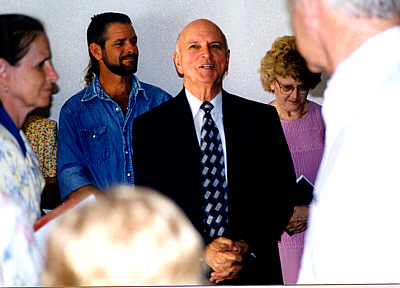General Board of Global
Ministries
![]()
UM Information
![]()
UM Reporter
![]()
![]()
Favorite Places
![]()
![]() Florida Southern College
Florida Southern College
![]()
![]() Bethune Cookman College
Bethune Cookman College
![]()
![]() FL
UM Children's Home
FL
UM Children's Home
![]()
|
|
Coordinators prepare for upcoming disaster season |
|
Photo by Bill Rhan |
Melbourne District Superintendent W. Ray Finkles, middle, was on hand for the May 16 dedication of the new disaster supply depot at Mims UMC. The depot is the first sub-state depot in the Florida Conference, according to conference Disaster Response Coordinator Bill Rhan. The depot will house food, water and other supplies. |
By Michael Wacht LAKELAND — June 1 is a noteworthy day in the Florida Conference. It’s the first day of the Dare to Share Jesus 1999 Florida Annual Conference Event. It’s also the first day of hurricane season. While much of the conference’s attention is focused on the event in Lakeland, Florida Disaster Response Coordinator Bill Rhan is working to get churches ready for the natural disasters that are common to Florida in the summer. “Disasters happen at the most inopportune times, ” he said. “Even the small churches need to be prepared to respond.” Although Florida felt little of the impact of last year’s storms, 1998 “was a very active season with 14 named tropical storms, of which 10 became hurricanes,” according to the National Oceanic and Atmospheric Administration’s (NOAA) National Hurricane Center. This year’s season is expected to be just as busy. Dr. William Gray, a meteorology professor at Colorado State University and one of the top hurricane forecasters in the United States, predicts there will be 14 named storms between June 1 and Nov. 30. He says nine of those storms are predicted to become hurricanes; four will be intense — category III or stronger. With the impending hurricane season, the continuing high risk of wildfires and the constant threat of severe weather, Rhan says every church in the Florida Conference should have a disaster response plan. To help churches in that process, Rhan has developed a blueprint for a local church disaster response plan that is available in conjunction with training on disaster response. Rhan says there are key things churches can do to prepare for any type of disaster:
Communication is key to a successful disaster response. Rhan says that when disaster strikes, the local church should immediately contact its:
After the disaster has been confirmed by the local emergency management authority, the church should contact:
For more information on disaster response training or the local church response plan, contact Rhan at 904-454-7755 or TENTDOC@aol.com. Top
of this page |

